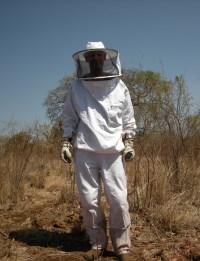Dr. Caspar Schöning

Wissenschaftlicher Mitarbeiter
CV
Seit September 2012:
Wissenschaftlicher Mitarbeiter an der FU Berlin in der Arbeitsgruppe von Prof. Susanne Wurst (Funktionelle Biodiversität).
März 2008 – Februar 2011:
Wissenschaftlicher Mitarbeiter am Länderinstitut für Bienenkunde, Hohen Neuendorf.
Januar – Februar 2008:
Feldforschung zur Verhaltensökologie von Treiberameisen am Mount Kenya (Kenia) in Kooperation mit Dr. Joseph Ogutu vom International Livestock Research Institute, Nairobi.
April – Dezember 2007:
Feldforschung zur Insektivorie von Berggorillas in Bwindi (Uganda) in Zusammenarbeit mit Dr. Martha Robbins vom Max-Planck-Institut für Evolutionäre Anthropologie in Leipzig.
Dezember 2004 – März 2007:
Wissenschaftlicher Mitarbeiter in der Arbeitsgruppe von Prof. Jacobus Boomsma am „Department of Population Biology“, Universität Kopenhagen (Dänemark).
Dezember 2000 – Mai 2004:
Doktorarbeit an der Freien Universität Berlin zum Thema “Evolutionary and behavioural ecology of Dorylus army ants“.
Oktober 1995 – August 2000:
Studium der Biologie an der Freien Universität Berlin.
Forschungsinteressen
Pflanzen-Insekten-Interaktionen
Verhaltensökologie von sozialen Insekten
Derzeitiges Projekt
Projekt B3 „Priming of plant defence by below- and aboveground herbivores“ in dem von der Deutschen Forschungsgemeinschaft geförderten Sonderforschungsbereich 973.
http://www.sfb973.de/research/Project_B3/index.html
Publikationen (peer-reviewed)
Schöning C, Wurst S (akzeptiert). Positive effects of root-knot nematodes (Meloidogyne incognita) on nitrogen availability do not outweigh their negative effects on fitness in Nicotiana attenuata. Plant and Soil
Koops K, Schöning C, Isaji M, Hashimoto C (2015). Cultural differences in ant-dipping tool length between neighbouring chimpanzee communities at Kalinzu, Uganda. Scientific Reports 77: 12456
Koops K, Schöning C, McGrew WC, Matsuzawa T (2015). Chimpanzees prey on army ants at Seringbara, Nimba Mountains, Guinea: Predation patterns and tool use characteristics. American Journal of Primatology 77: 319-329
Lechner S, Ferretti L, Schöning C, Kinuthia W, Willemsen D, Hasselmann M (2014). Nucleotide variability at its limit? Insights into the number and evolutionary dynamics of the sex-determining specificities of the honey bee Apis mellifera. Molecular Biology and Evolution 31: 282-287
Gruber K, Schöning C, Otte M, Kinuthia W, Hasselmann M (2013). Distinct subspecies or phenotypic plasticity? Genetic and morphological differentiation of mountain honey bees in East Africa. Ecology and Evolution 3: 3204-3218
Greggers U, Schöning C, Degen J, Menzel R (2013). Scouts behave as streakers in honey bee swarms. Naturwissenschaften 100: 805-809
Kleinschroth F, Schöning C, Kung'u JB, Kowarik I, Cierjacks A (2013). Regeneration of the East African timber tree Ocotea usambarensis in relation ot historical logging. Forest Ecology and Management 291: 396-403
Schöning C, Gisder S, Geiselhardt S, Kretschmann I, Bienefeld K, Hilker M, Genersch E (2012). Evidence for damage-dependent hygienic behaviour towards Varroa destructor-parasitised brood in the western honey bee Apis mellifera. Journal of Experimental Biology 215: 264-271
Kronauer DJC, Peters MK, Schöning C, Boomsma JJ (2011). Hybridization in East African swarm-raiding army ants. Frontiers in Zoology 8: 20.
Schöning C, Shepard L, Sen A, Kinuthia W, Ogutu J (2011). Should I stay or should I go now? Patch use by African army ant colonies in relation to food availability and predation. Insectes Sociaux 58: 335-343
Sanz CM, Schöning C, Morgan DB (2010). Chimpanzees prey on army ants with specialized tool set. American Journal of Primatology 72: 17-24
Kronauer DJC, Schöning C, D’Ettore P, Boomsma JJ (2010). Colony fusion and worker reproduction after queen loss in army ants. Proceedings of the Royal Society B 277: 755-763
Schöning C, Czusdi C, Kinuthia W, Ogutu J (2010). Influence of driver ant swarm raids on earthworm prey densities in the Mount Kenya forest: implications for prey population dynamics and colony migrations. Insectes Sociaux 57: 73-82
Schöning C, Njagi W, Kinuthia W (2008). Prey spectra of two swarm-raiding army ant species in East Africa. Journal of Zoology 274: 85-93
Schöning C, Kronauer DJK, Gotwald WH Jr, Vilhelmsen L, Boomsma JJ (2008). Taxonomy of the West African army ant Dorylus gribodoi Emery 1892 (Hymenoptera, Formicidae). Zootaxa 1749: 39-52
Schöning C, Humle T, Möbius Y, McGrew WC (2008). The nature of culture: technological variation in chimpanzee predation on army ants revisited. Journal of Human Evolution 55: 48-59
Schöning C, Moffett M (2007). Driver ants invading a termite nest – why do the most catholic predators of all seldom take this abundant prey? Biotropica 39: 663-667
Kronauer DJC, Schöning C, Vilhelmsen L, Boomsma JJ (2007). A molecular phylogeny of Dorylus army ants provides evidence for multiple evolutionary transitions in foraging niche. BMC Evolutionary Biology 7: 56. http://dx.doi.org/10.1186/1471-2148-7-56
Schöning C, Ellis D, Fowler A, Sommer V (2007). Army ant availability and consumption by chimpanzees (Pan troglodytes vellerosus) at Gashaka / Nigeria. Journal of Zoology 271: 125-133
Schöning C, Kinuthia W, Boomsma JJ (2006). Does the afrotropical army ant Dorylus (Anomma) molestus go extinct in fragmented forests? Journal of East African Natural History 95: 163-179
Kronauer DJC, Schöning C, Boomsma JJ (2006). Male parentage in the army ant Dorylus (Anomma) molestus. Molecular Ecology 15: 1147-1151
Schöning C, Kinuthia W, Franks NR (2005). Evolution of allometries in the worker caste of Dorylus army ants. Oikos 110: 231-240
Schöning C, Njagi W, Franks NR (2005). Temporal and spatial patterns in the emigrations of the army ant Dorylus (Anomma) molestus at Mt Kenya. Ecological Entomology 30: 532-540
Kronauer DJC, Schöning C, Pedersen J, Boomsma JJ, Gadau J (2004). Extreme queen-mating frequency and colony-fission in African army ants. Molecular Ecology 13: 2381-2388
Schöning C, Espadaler X, Hensen I, Roces F (2004). Seed predation of the tussock grass Stipa tenacissima L. by ants (Messor spp.) in southeastern Spain: the adaptive value of trypanocarpy. Journal of Arid Environments 56: 43-61
Schöning C, Flieger M, Pertz H (2001). Complex interactions of ergovaline with 5-HT2A, 5-HT1B/1D and alpha1 receptors in isolated arteries of rat and guinea pig. Journal of Animal Science 79: 2202–2209
